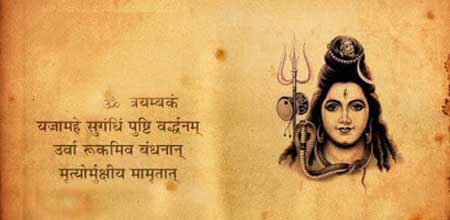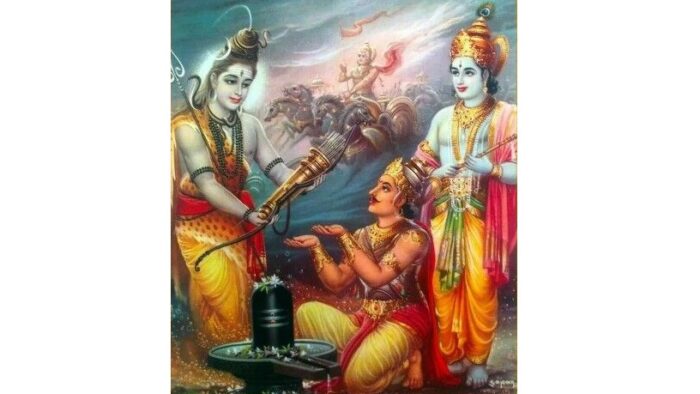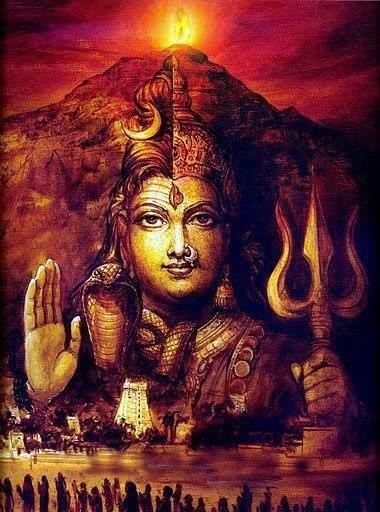No products in the cart.
The word Pshupata is derived from Lord Shiva’s famous epithet Pashupati, meaning “The Lord of the Animals” or “The Lord of All Living Beings.” All people, including humans, are treated as animals until they gain emancipation in Saivism. Shiva is the spouse or Lord of the Universe. Pashupati is his name because of this.
He is also the ruler of our animal nature, which is a direct result of Tamas, one of the three gunas he represents. His chariot (Vahana), the holy bull Nandi, personifies the animal (Pasu or Pashu) or the animal character (particularly passion or virility), and he rides it as its ruler.

Celibate ascetics are recommended to worship Shiva to achieve control over their cravings and lusty thoughts, as are anybody who has problems with their emotions, harsh nature, lethargy, wrath, envy, evil ideas, and demonic conduct because of his power over our sexual nature and animal instincts.
Pāsa as- the bonds
Pashupata refers to the route that leads to Pashupati, or to Pashupati’s serene, omniscient condition, or to Pashupati’s union (yoga). Paashupata is the conventional pronunciation. It is formed by combining the terms psa and patha. A rope, chain, or fetter is referred to as pasa. It symbolises the links or attachments that beings establish with material objects on Earth as a result of cravings and illusions.
Pasa can also refer to a snare or trap. In the iconography of Shaivism, it alludes to the snare or the trap created by Shiva, the Lord of the universe, to catch beings by laying upon them the net of illusion. Hence, Shiva is also known as Mayavi, the magician.
Pāsa as- the noose
Pasa also refers to the noose, which is used by Hindu gods such as Lord Ganesha, Varuna, and Yama as a weapon. Pashupata, in this context, refers to the sword that destroys (pathana) pasas, or wants and attachments, and frees people from the net of ignorance and delusion. When the bindings are cut (cheda), one obtains freedom or oneness with Rudra by performing the Pashupata Vrata according to the established process (vidhi) (Rudra Sayujya).
Pashu as- the animal
Pashupatha also refers to the concept that by joining with Shiva, beings in the animal condition (pashu) can escape the cycle of births and deaths. Pshupata refers to the road that animals use to reach Lord Shiva, who is known as Pashupathi.
In Shaivism, all living beings are referred to as pashus, or embodied souls (jivas), who are trapped in a cycle of births and deaths and vulnerable to the three impurities of egoism, attachments, and delusion. For these beings, Pshupata is the path to emancipation (pasus). The only word that derives from pasa is pasu.Pasa or pasana refers to entities that are linked (pasa) to cause and effect, as well as the cycle of births and deaths. Upasana is a spiritual action that weakens the pasanas or pasas in several traditions. Dependence, cause and effect, and bondage are all characteristics of pasutva, or animal nature. Because Kala limits cause and effect, all things are subject to birth and death (time).
A pashu (body or nature) and a pati (mind) make up each individual (the soul or Shiva). The route or doctrine that leads to the destruction (patana) of the animal (pasu or body) in beings and the emancipation of Pati (the soul) who is bound in Samsara is referred to as Pshupatha (the cycle of births and deaths). As Lord of the Animals, Lord Shiva supervises the process, functioning as both subject and object, as well as teacher (guru), spouse (pati), and liberator (Isvara).
Pasupathastram
Pshupata is also the name of a weapon of mass destruction with the same name (psupathastram). Arjuna got it on Lord Krishna’s counsel by performing a hard penance (Pshupata Vrata) and propitiating Lord Shiva on the hill of Indra Kiladri near Vijayawada, which according to some sources is located on the banks of the Krishna River.

The Pashupatastra is Shiva, Kali, and Adi Para Shakti’s irresistible and most devastating personal weapon, which may be launched by the thoughts, sight, words, or a bow. The Pashupatastra is capable of destroying creation and vanquishing all things and should never be employed on weaker foes or by lower warriors.
Pāshupata Shaivism
There were four disciples of Lakulisa. They disseminated his ideas and established a lengthy line of instructors and teacher traditions that spanned generations. His teaching was known by both Shankaracharya and Abhinavaguta. The Pasupata Sutra, as well as a few Upanishads and comments or expositions on it by Kaundinya, Madhavacharya, and Haradattacharya, include some of Lakulisa’s teachings.
Pashupatha Saivism combines elements of devotional theism, classical Yoga, ceremonial worship, and Tantric self-control and purifying procedures (vama marga). The sect’s adherents believed in rebirth, but saw karma as subordinate to Shiva’s will and favour. Unlike Vedic religion adherents, the Pashupathas valued proximity to Shiva (samipya) and union with him (sayujya) over a temporary or permanent stay in an ancestral heaven or everlasting heaven.
The outcome (karya), the fundamental cause (karana), the spiritual means to gain unity with Shiva (yoga), observances and ritual practises (vidhi), and the end of suffering are the five basic truths (pancharthas) identified by the Pashupata school (dukhanta).
The Pashupatha Vrata, which was performed in four phases until the aspirant conquered his shortcomings and imperfections and became an adept, is the primary way of redemption. Eight Ganas, or groups of practises, were added to it, each with five emphasis areas. They helped the seekers purify and liberate themselves. The four phases of the Pashupatha Vrata, commencing with initiation and concluding with ultimate departure, are in many ways sub stages of the Vedic Varnashrama Dharma’s Fourth Ashrama (Sanyasa).
In ancient and mediaeval India, the sect was immensely popular, but it is now defunct. Hiuen Tsang, a Chinese Buddhist pilgrim, saw hundreds of Pasupatas in both the north and south of India during his travels in the seventh century. Although it is now extinct, its significance stems from the fact that its ideas and practises were adopted by various other Saiva sects, particularly those belonging to the atimarga (extreme) Saiva lineages.
It’s possible that the cult began as a Vedic reaction against non-Vedic Shaivism groups or those who opposed the traditional caste system, which offered special benefits to the upper castes at the expense of the lower castes. Because of changes in the Indian social and political environment, the role may have changed throughout time. “Pasupatas were the first to toss away their caste hurdles and recall similar popularity to everyone,” says Prof. B.S. Chandrababu. “They were also the first Indian sect to conduct a campaign in opposition to caste enterprises and the oddities that it caused.” According to the same author, there was spiritual strife among Buddhists, Jains, Kapalikas, and Pasupatas inside the Pallava kingdom. “Moreover, a number of saiva sects, such as the Kapalikas and Pasupatas, were no longer amicable.”
In all honesty, we can speculate that the Pasupatas relaxed their caste requirements in the future to increase their numbers or to correspond to the norms of many ascetic sects, which accepted people from all walks of life as long as they were judged suitable for initiation in various ways. The same attitude is also shown in the words of Acharya Haribhadra (960 A.D.) and Rajasekhara Suri (1348), who stated of their works that everyone, regardless of caste or gender, should be saved provided they were introduced into the course and continued the activity for 12 years. The Vira Saiva sect, which condemned the caste system and accepted people of all origins, eventually pushed the principle to its extreme.
Despite the fact that Pasupata is a theistic system that promotes devotion and devotion, it is substantially distinct from other theistic traditions, particularly Vaishnavism. Because it regards all beings as Shiva exclusively, the group does not believe in serving God or in taking the shape of a slave monarch and having a connection with him. Their core deities are not diminished or taken as slaves by their simple presence in a condition of captivity and ignorance (dasas). As a result, rather than focusing on the route of freedom, it fosters a spirit of independence, believing that genuine freedom is impossible if one is reliant on anything other than oneself.
Shiva became neither a concept, an image, or an idea for the Pasupata sect. He became an everlasting, verifiable reality, which I believe may be gained and experienced at the same time via self-transformation and austere effort. The machine may have recommended harsh procedures that were unpalatable to the civilised world, but they were designed to disrupt the seekers’ training and habitual thought and behaviour in order to free them from the grip of authority, society, and conformity.
True emancipation begins with the removal of all external influences, constraints, causes, and restraints. To achieve that austere and sacred goal, one need a comprehensive strategy to destabilise the entire persona and shake off ingrained illusions and false ideals, allowing it to be rebuilt or reorganised for far higher insight, knowledge, and focus.
Also read






